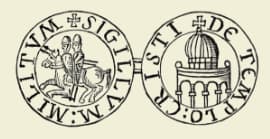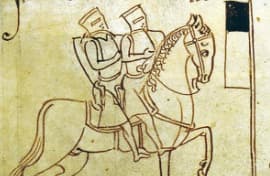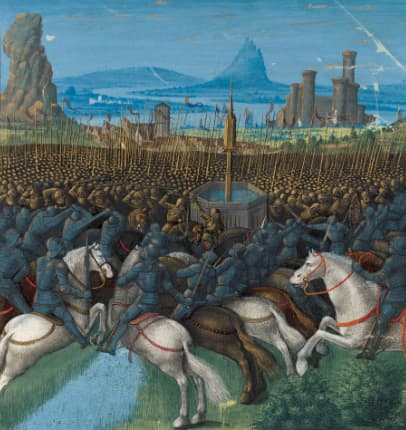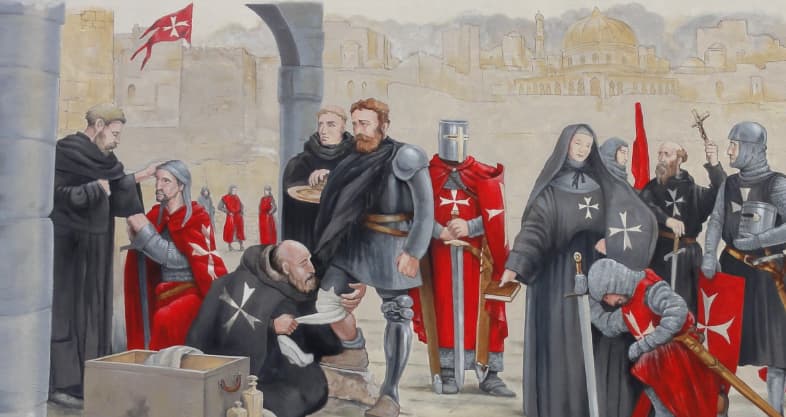- Prior to 1119, when the Templars were founded, religious orders were always non-combatants during military campaigns
- The Templars’ initial members consisted mainly of brothers-at-arms
- The Hospitallers were in charge of Jerusalem’s Hospital of St. John
- With the Holy Land increasingly unsafe, the Hospitallers took up arms out of necessity to defend those in their hospital’s care
Prior to the Crusades, religious orders were dedicated to charitable works and prayer. As such, they were non-combatants during military campaigns. This began to change in the late months of 1119, when in response to religious tension and social unrest, a brotherhood called the Templars was founded in Jerusalem.
The Templars

A Seal of the Knights Templar
Around this time, the Hospitallers were also formed. Other than sharing a common geographical area around the time of their founding, the Hospitallers and the Templars were entirely separate and distinct. The Hospitallers had a charism for serving the poor and sick, and ran the Hospital of St. John. The Templars, however, played no part in Jerusalem’s medical care during this tumultuous era.
The Templars were originally led by Hugues de Payens. Initially, this small group of knights served to protect the pilgrim roads from bandits.
But, as the political climate surrounding the Holy Land became increasingly turbulent during the late eleventh and twelfth centuries, the Templars became a large fighting force sworn to defend the Latin Kingdom of Jerusalem.

Painting of the Templars from the exhibition in the Templars Crusader Tunnel
The existence of the Templars put into question whether there could be a religious order that practiced not only military defense of the poor and vulnerable, but also charity and hospital care.

Depiction of two Templars seated on a horse (emphasizing poverty)
Much like other religious orders of the day, the Templars took vows of poverty, chastity, and obedience. Yet, their existence was controversial due to their participation in the violence of the crusades.
The existence of the Templars put into question whether there could be a religious order that practiced not only military defense of the poor and vulnerable, but also charity and hospital care.
Militarization of the Hospitallers
Whereas the Templars were formed for the express purpose of military defense and whose initial members consisted mainly of brothers-at-arms, the Hospitallers ran the Hospital of St. John and only took up arms as an ancillary necessity to defend those in their care.
Though the exact year in which Hospitallers took up arms is unknown, there are references to brothers-at-arms within the Hospitallers by the second half of the 12th century.
During the crusades, the Holy Land was increasingly unsafe for both its pilgrims and residents. The Hospitallers felt called to serve, heal, and eventually protect these communities. In the absence of any police force or stable government at the time, the Hospitallers were required to defend their institutions to continue their care of the poor and sick.
Though the exact year in which Hospitallers took up arms is unknown, there are references to brothers-at-arms within the Hospitallers by the second half of the 12th century.
Over time, the Hospitallers grew in strength and numbers, even acquiring a number of fortresses and castles of strategic importance for the Holy Land’s defense. Together these formidable structures comprised a crucial defense of the Holy Land’s frontier against Turkish invaders.
Keep in mind that it was fairly commonplace for secular knights on pilgrimage to offer their services to one institution or another once they arrived in Jerusalem.
The development of a military wing within the Hospitallers seems to have had its origins in the religious aspirations of secular knights who wished to commit their skills to the care of the poor and sick in Jerusalem.

Battle of Hattin in 1187
With the taking of Jerusalem by Saladin in 1187, many of these fighting men were in need of employment while they discerned whether to remain in the Holy Land or return to Europe.
It seems reasonable that the Hospital of St. John would benefit from an attachment of secular knights, who would have served either for pay or out of devotion. In the 1120s, a number of knights bequeathed their horses and arms to the Hospitallers, demonstrating their commitment to the Order’s work.
That being said, the development of a military wing within the Hospitallers seems to have had its origins in the religious aspirations of secular knights who wished to commit their skills to the care of the poor and sick in Jerusalem. In fact, the first reference to the brothers-at-arms lists this military function only after the Order’s other charitable duties. We can infer, therefore, that brothers-at-arms were first and foremost Hospitallers, and “knights” second.
Though the Hospitallers’ mission of caring for the poor and the sick was kept as their first and ultimate priority, the Hospitallers, eventually renamed the Order of Malta, continued to have religious brothers-in-arms for another 600 years up until the loss of the island of Malta to Napoleon's navy during his 1798 Egyptian campaign.
Today, the Order of Malta’s military legacy is reflected in the structure of its works and its resolute commitment to care for the wounded in times of war.

